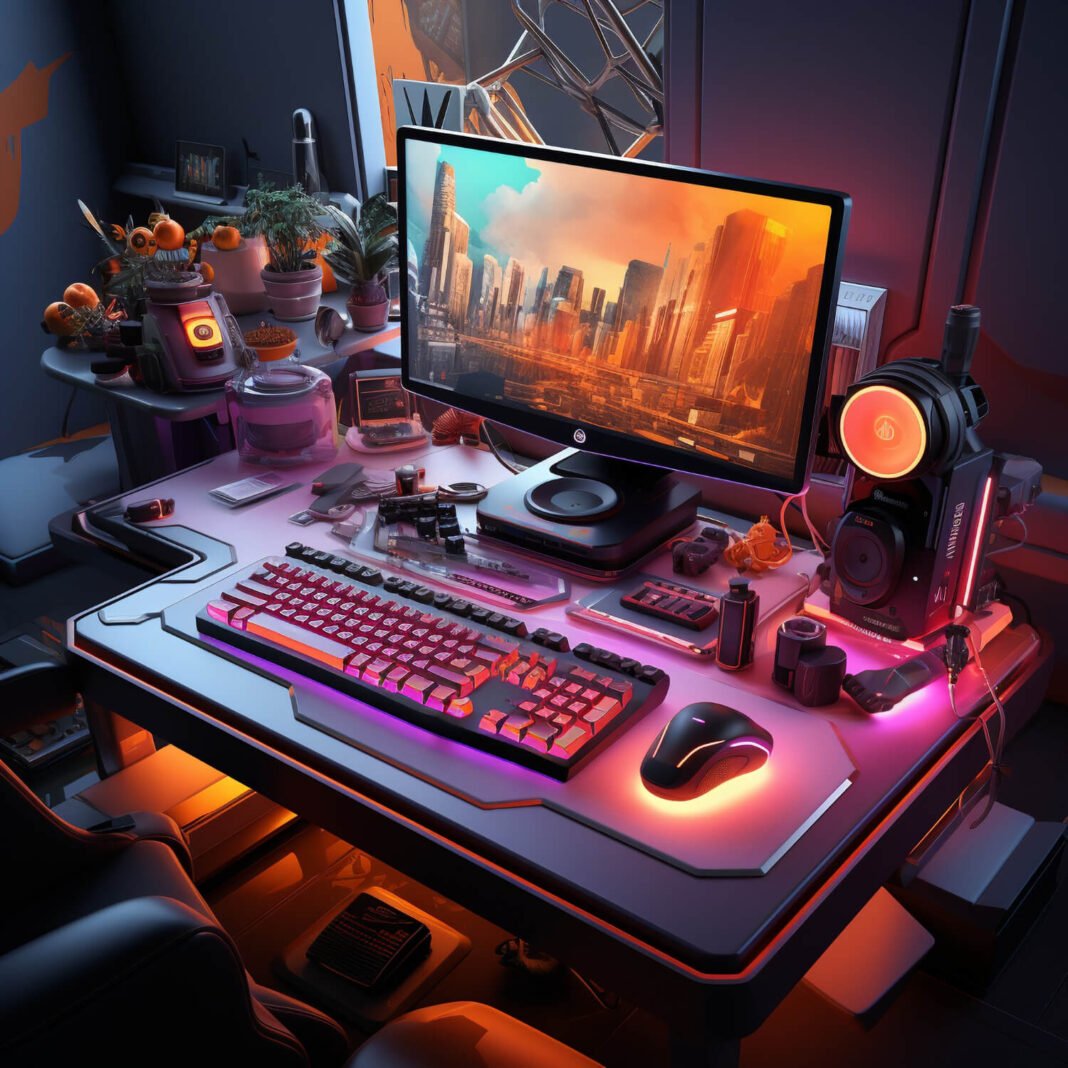Building your own gaming PC can be both an exciting and rewarding experience. But with so many components and specifications to consider, you might wonder: How do I ensure that my build delivers the best performance for gaming in 2024? Whether you’re a seasoned enthusiast or a first-time builder, this step-by-step guide will help you create a dream gaming rig that maximizes power, performance, and future-proofing.
Why Build Your Own Gaming PC?
Building a gaming PC allows you to tailor your setup to your exact needs, whether you’re focused on high-end graphics, faster load times, or multitasking capabilities. By handpicking each component, you can get the most out of your budget and create a system designed specifically for the games you love to play.
Table of Contents
- Introduction to Building a Gaming PC
- Step-by-Step Guide to Building Your PC
- Setting Your Budget
- Choosing the Right Components
- The Best Gaming PC Components for 2024
- CPUs
- GPUs
- RAM
- Storage Solutions
- Motherboards
- Power Supply Units (PSU)
- Cases and Cooling
- Assembly: Building Your Gaming PC
- Optimization and Maintenance
- FAQs
- Conclusion

Step-by-Step Guide to Building Your Gaming PC
1. Setting Your Budget
The first step in building a gaming PC is deciding how much you’re willing to spend. PC builds can range from $800 for a budget-friendly system to well over $3000 for high-end machines. Your budget will determine the quality and performance of each component.
- Budget build ($800 – $1000): Focus on cost-effective parts like mid-range CPUs and GPUs.
- Mid-tier build ($1000 – $2000): Expect better performance and more advanced cooling, SSDs, and higher RAM.
- High-end build ($2000+): Aim for the best CPUs, GPUs, and additional features like overclocking capabilities and top-tier cooling systems.
2. Choosing the Right Components
Building a gaming PC requires a well-balanced selection of components. Below are the essential parts you’ll need:
Best Gaming PC Components for 2024
1. CPU (Central Processing Unit)
Your CPU is the brain of your PC. For gaming, it handles instructions and controls game physics, AI, and logic.
- Intel Core i9-13900K: One of the best gaming CPUs, offering excellent single-core performance.
- AMD Ryzen 9 7950X3D: Known for its multi-core efficiency, ideal for multitasking and gaming.
2. GPU (Graphics Processing Unit)
The GPU is the heart of any gaming PC, responsible for rendering graphics and images. For 2024, the latest GPUs are pushing the boundaries of ray tracing and 4K gaming.
- NVIDIA GeForce RTX 4090: Dominates the market with exceptional 4K gaming performance.
- AMD Radeon RX 7900 XTX: A strong competitor to the RTX 4090, offering excellent value for high-resolution gaming.
3. RAM (Memory)
For gaming, 16GB of RAM is the bare minimum, but 32GB is recommended for future-proofing and multitasking.
- 16GB DDR5-6000MHz: A great balance of speed and capacity for most gamers.
- 32GB DDR5-6000MHz: Ideal for streamers, content creators, or those looking to future-proof.
4. Storage Solutions
Having fast storage is crucial for gaming. SSDs significantly reduce game load times, while larger HDDs can be used for mass storage.
- NVMe SSD (1TB): Ultra-fast storage for quick load times and efficient file access.
- HDD (2TB – 4TB): Great for storing large game libraries or media.
5. Motherboard
Your motherboard connects all your components and ensures smooth communication between them. It’s important to choose one that supports your CPU and has features like PCIe 5.0 for future GPUs.
- ASUS ROG Strix Z790-E Gaming: Perfect for Intel-based builds with PCIe 5.0 support and robust VRMs.
- MSI MPG B650 Tomahawk Wi-Fi: Ideal for AMD Ryzen builds, offering good value and support for DDR5.
6. Power Supply Unit (PSU)
The PSU delivers power to your components. Choosing the right wattage and quality is essential for system stability.
- Corsair RM850x (850W): Suitable for most mid to high-end gaming PCs.
- Seasonic Prime TX-1000 (1000W): Great for power-hungry setups with multiple GPUs or heavy overclocking.
7. PC Case and Cooling
Your case is not just an aesthetic choice; it also influences airflow and cooling. Ensure that your case supports your build’s cooling needs.
- NZXT H510 Elite: A sleek mid-tower with excellent airflow and cable management.
- Fractal Design Meshify 2: Ideal for enthusiasts who want a spacious case with superior cooling.
Cooling Solutions
Proper cooling prevents your system from overheating during extended gaming sessions.
- Noctua NH-D15: One of the best air coolers available.
- Corsair iCUE H150i Elite Capellix: A powerful AIO (All-in-One) liquid cooler, ideal for high-end builds.
Assembly: Building Your Gaming PC
1. Prepare Your Workspace
Before starting, clear a large, static-free workspace. Ensure you have the right tools, such as a screwdriver and thermal paste.
2. Install the CPU
- Align the CPU with the motherboard socket and lock it in place.
- Apply thermal paste and install the CPU cooler.
3. Install RAM and Storage
- Insert the RAM into the motherboard slots, ensuring they click into place.
- Install your SSD into the M.2 slot, or connect the SATA cables for traditional SSDs or HDDs.
4. Mount the Motherboard
- Secure the motherboard inside your case using the standoffs provided.
5. Install the GPU
- Insert the GPU into the PCIe slot and secure it with screws.
6. Connect PSU and Cables
- Mount your PSU and connect the necessary power cables to your motherboard, GPU, and storage devices.
7. Test the Build
Before closing the case, test the build by powering it on. If it boots to BIOS, your installation was successful.

Optimization and Maintenance
Overclocking
To squeeze even more power out of your PC, consider overclocking your CPU and GPU. However, be mindful of the increased heat output and power consumption.
Regular Maintenance
- Clean Dust Filters: Every few months, clean the dust filters to ensure airflow remains optimal.
- Update Drivers: Ensure your GPU drivers and motherboard BIOS are up-to-date for the latest performance enhancements.
- Monitor Temperatures: Use software like HWMonitor or MSI Afterburner to keep track of system temperatures during gaming.
Frequently Asked Questions (FAQs)
1. How much should I spend on a gaming PC in 2024?
Your budget will depend on your gaming needs. For 1080p gaming, $1000 can provide a solid build, while 4K gaming may require a $2000+ investment.
2. How long will a gaming PC build last before I need to upgrade?
Most gaming PCs can last 4-6 years before needing significant upgrades. However, replacing components like the GPU or adding more RAM can extend its lifespan.
3. Is it difficult to build a gaming PC for the first time?
Building a gaming PC may seem daunting, but with the right guide and a bit of patience, even beginners can successfully complete their first build.
4. Do I need liquid cooling for my gaming PC?
For most builds, high-quality air cooling is sufficient. Liquid cooling is recommended for overclocked or high-end PCs, especially if you want to reduce noise or improve aesthetics.
5. Can I upgrade my gaming PC later?
Yes, one of the major benefits of building a gaming PC is the ability to upgrade components over time.
Conclusion
Building your own gaming PC in 2024 is a rewarding process that allows you to customize your machine for the best gaming performance possible. By carefully selecting the right components, you can create a gaming powerhouse that meets your needs today and can be upgraded for years to come. Whether you’re into casual 1080p gaming or pushing the limits with 4K resolution and ray tracing, this guide has all the information you need to get started. Happy building!


